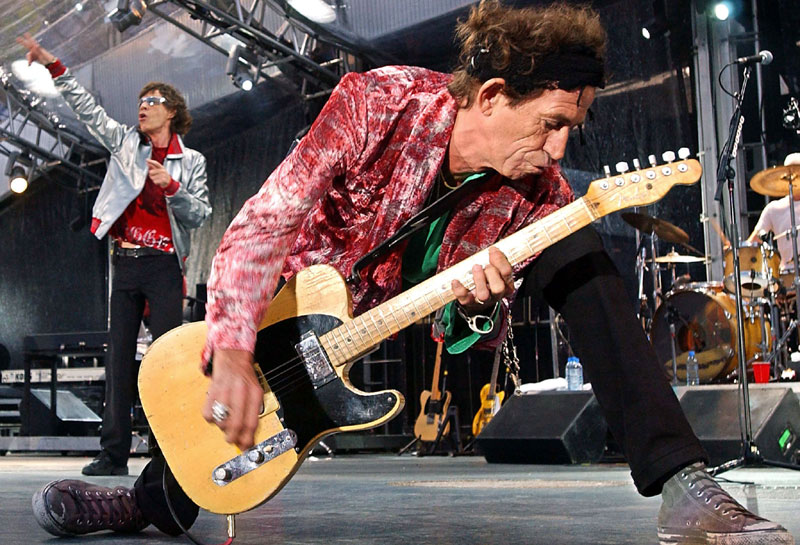If rock’n’roll could be turned into flesh and made to walk the earth, it would look and sound a lot like Keith Richards.
It’s not the skull ring, the elegantly wasted appearance or the chemically-enchanced bloodstream that does it – although that all helps – but the fact that he has an unerring knack of hoovering up pretty much all of the greatest guitar riffs ever written. But what are the candidates? He’s cheated death more times than can be imagined..so, here are some of my personal selections – and believe me, it’s only the beginning.
One of Keith’s most world-famous riffs, it’s sort of surprising to learn that this track was originally conceived as a reggae number and took the band six years to get right after originally trying it out in 1975. It’s now so instantly recognizable that it’s the riff that Keith uses to announce himself and Mick at the Rock’n’Roll Fantasy Camp in The Simpsons.
‘Beggars Banquet’ is the first in a flawless four-album run that lasted from 1968 to 1972, and this is its centre point. An exhilarating kicking-against-the-pricks moment, it also proves beyond question that great guitar riffs don’t have to be electric.
In his cracking autobiography ‘Life’, Richards talks lovingly about how much the open G guitar tuning changed his playing forever – and this is a great example of how it sounds at its best: deep-fried and filthy.
Part of Keith’s genius is his ability to make a great riff work for a slower ballad just as well as a foot-stomping rocker. He’s not concerned with being the centre of attention: Ronnie Wood plays the solo, and throughout the song their guitars weave interchangeably, but the woozy riff is pure Richards.
Now that’s how you announce a song: those opening staccato notes sound the alarm before the definitive hip-wiggling riff, the perfect companion for Jagger’s taboo-crushing tale sadomasochistic slave rape with a taste of heroin.
Written late at night in the elegant front room of Keith’s French chateau, Villa Nellcôte, this is a Richards riff at his laidback, rolling best. The rest of the song just hangs on as best it can and lets it glide.
Another cut from ‘Exile On Main Street’, Mick Taylor’s slide guitar is great but again it’s all about Richards’ driving riff that makes this track a classic.
Back at the dawn of time, before MP3s had even been dreamt of and all records had to be turned over halfway through, this was the opener to side two of ‘Sticky Fingers’. Given that the opener of side one was ‘Brown Sugar’, this had to be special – and it might even be a better riff. As unstoppable as a freight train with burnt-out brakes.
‘Exile’s’ opener turns around on itself a couple of times, then kicks into maybe the druggiest, most strung-out riff of all time – and that’s a category with a fair bit of competition. As Keith himself sings, it’s “zipping through the days at lightning speed.”
Is there any sound more exciting that the opening lick of ‘Can’t You Hear Me Knocking’? No, frankly. Ted Demme knew this when he set the opening cocaine-production montage of the Johnny Depp-starring ‘Blow’ to this tune. As Keith himself wrote in ‘Life’: “‘Can’t You Hear Me Knocking’ came out flying – I just found the tuning and the riff and started to swing it and Charlie picked up on it just like that, and we’re thinking, hey, this is some groove. So it was smiles all around. For a guitar player it’s no big deal to play, the chopping, staccato bursts of chords, very direct and spare.”
The legend goes that he wrote this one in his sleep. Or at least, he woke up just long enough to play it into a tape recorder before falling asleep – the recorder capturing him dropping the pick and then “snoring for the next forty minutes.” Keith wanted his riff sketch to be replaced by horns – as Otis Redding would eventually do on his cover – but manager Andrew Loog Oldham convinced him to release it as it was and his signature sound – and a legend – was born.
After mucking around with psychedelia – with dubious amounts of success – on ‘Their Satanic Majesties Request’, the Stones announced their return to rock’n’roll with Richards’ greatest ever riff. Mind-blowingly cool, it went on to soundtrack everything from Scorsese’s ‘Mean Streets’ to Johnny Depp’s Hunter Thompson driving off into the desert at the end of Terry Gilliam’s ‘Fear and Loathing in Las Vegas’. As for the riff itself? Well, as Keith says: “It just floats there, baby”.
by Wallace McTavish


